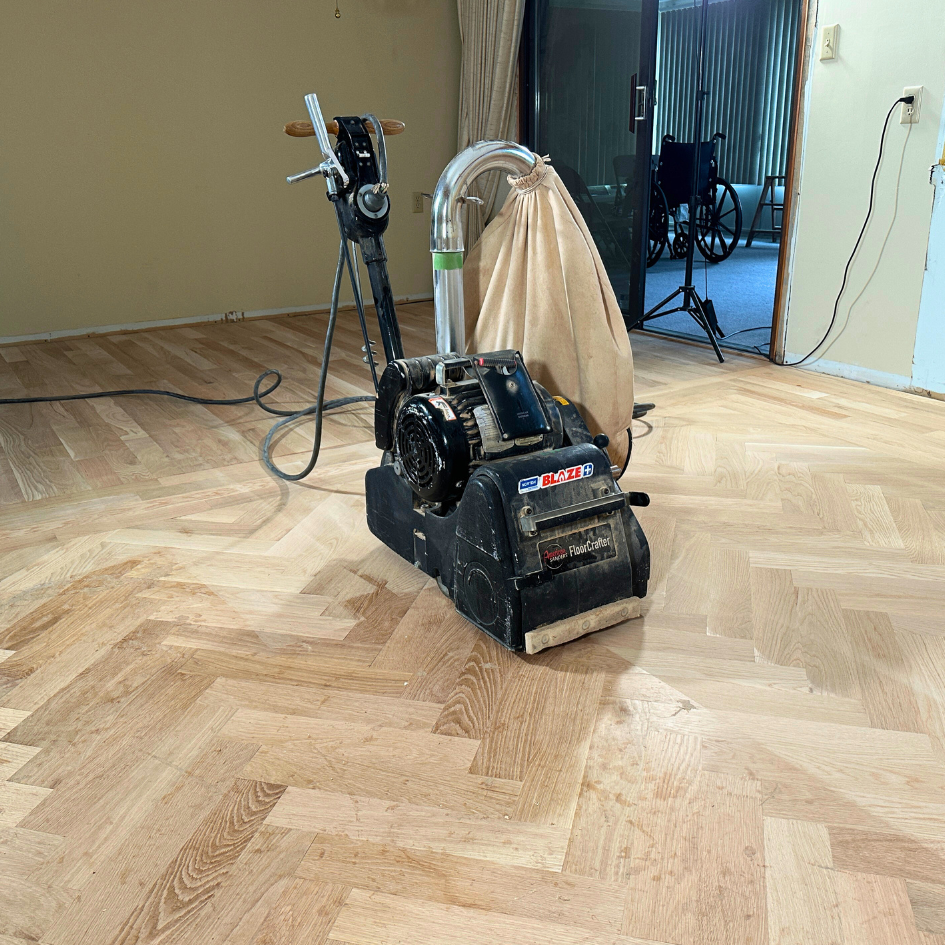If you're getting ready to have your hardwood floors redone, you're likely wondering how much dust will be left after the refinishers are done. Brace yourself because the answer isn't simple – it depends on a few things.
Types of Hardwood Sanding Dust Control Systems:

Canvas Bag Systems:
If your refinisher relies on standard canvas bag systems, it's an old method, dating back over a century. It works well for certain machines like the belt sander but not so much for others like a floor edger. If your hardwood contractor only uses this system, be ready for a good amount of dust.
.png)
Vacuum Method:
More advanced systems use large vacuums, some powered by 240 volts. They're connected to the sanding machines, filtering out dust through cloth and paper filters. Some refinishers use HEPA grade vacuums, known for superior filtration. While they sound great, they don't always make a huge difference because most dust escapes from the sander itself, not the vacuum.
So, what really matters is how careful your hardwood refinishers are. Even with an excellent dust containment system, a careless refinisher can leave your home in a mess. This often happens due to poor connections to the dust vacuums, improper dust shrouds, and other small issues that add up to a lot of dust being left in your home.
While HEPA vacuums are often mentioned at the estimate and in marketing by your hardwood contractor, what truly counts is having a refinisher committed to meticulous dust containment. This involves careful attachment of dust shrouds, strategic taping to enhance suction, and an overall investment of time by the refinisher.
If you're going for budget-friendly refinishers, keep in mind they might not spend enough time to ensure optimal dust containment, even if they have a good system.
At our company, we prioritize containing dust within our clients' homes. BUT, we also tell you from the start, that some dust is going to get out and you're going to have to do some cleaning. Now, we do try to minimize this by taking our time as we go but also by cleaning up. This includes wiping down baseboards, countertops, and window sills. That being said, if you prefer to do this yourself and save money, just let the contractor know during the estimate.
What preparations should the contractor make before sanding?
At the end of the day, nothing beats a hardwood refinisher who takes the time to properly protect areas that shouldn't accumulate dust. A quality refinisher will ensure items like kitchen cabinets, built-in bookcases, and open doorways are well-protected with plastic coverings. If you're working with a tight budget, consider offering to do these things for them to save them time.
What preparations are the homeowner's job?
Certain things should be done on your end too. Remove curtains, paintings, and family photos from the walls. Clear countertops completely, and consider turning off your heating and air conditioning after consulting with the refinisher due to the specific temperature requirements for proper drying (DO NOT DO THIS WITHOUT TALKING TO THEM).
In an ideal scenario, hardwood refinishing aligns with repainting your house and cleaning your ducts simultaneously, but we understand that's not always feasible. If you're doing these other steps, dust may not be a big deal to you, as the painter will be coming behind the refinisher and able to handle small amounts of dust since he may be sanding your walls anyways.
If you're planning to refinish the floor yourself (DIY), how much dust should you expect?
If you're tackling it as a DIY project, there's going to be a ton of dust unless you go the extra mile. The standard rental tools generally run exclusively off canvas dust bags, making them much worse at collecting dust.
If you're willing to invest extra money, you can rent large dust containment vacuums and go through the process of connecting them to the rental sanders. Most DIY sander rental shops don't have dust vacuums specifically made for the floor sanders. That means you'll need to find some fittings to connect the hoses or use a lot of duct tape. It can be done! Just don't expect the rental desk to have the answers for you on how to do it.
How to evaluate a hardwood contractor's level of dust containment?
Lastly, when evaluating a potential hardwood flooring contractor, ask about their cleanliness practices and just see what they say. If they assure everything is going to be spotless, I would be very skeptical. At Lumberjack Hardwood Floors, we take a lot of precautions to protect our customers' homes from dust, but it would still be inaccurate to say there won't be any dust. We tell you at the start to expect some dust and some cleanup.
I would highly recommend taking a look at each contractor's reviews. They often provide insights into the contractor's cleanliness habits, giving you a better idea of what to expect. Cleanliness is one of the biggest concerns people have over hardwood floor refinishing, so it frequently shows up in the review whether good or bad.
If you really want to ask specific questions of your wood floor contractor, talk to them about the machines they use. Certain machines, like the Lagler Flip Edger and Bona Power Drive, excel at dust containment but are not the fastest options available to refinish contractors. Because of this, expect that a company that uses these machines will charge more money. And a quick note, ask specific questions like this at your own peril. Many contractors find these questions to be signs of a homeowner who is overly picky. If you give off those vibes at the estimate, you may never receive a quote or it may be exceptionally high.
In conclusion, while "dustless refinishing" may sound appealing in marketing, a realistic approach is crucial. Expect some dust, and focus on hiring a refinisher who prioritizes cleanliness and has a track record to prove it.
